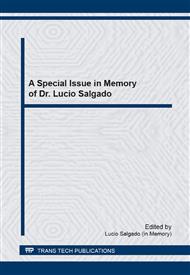p.667
p.672
p.678
p.684
p.690
p.694
p.700
p.706
p.712
Characterization of Metallic Zirconium Sponge
Abstract:
When used commercially, the zirconium alloys are utilized in the shape of tubes to encapsulate the UO2 pellets in the PWR and BWR Power reactors. The metallic zirconium is an essential metallic element for the types of alloys in which the obtainment route rests in the ore opening for the production of zirconium oxide followed by the processes of pelletizing, chlorination, purification, reduction and distillation. Through the technique of X-Ray Diffraction the present phases were identified. Using the Fluorescence of an X ray it was possible to determined the chemical composition of the zirconium sponge. The mechanical properties of Vickers microhardness were obtained using a microdurometer. As a result, it was established that it is possible to define a methodology for the preparation of a sample of metallic zirconium for the microstructure analysis, as well as that its chemical purity is 97,265% linked to the microhardness of approximately 51 HV.
Info:
Periodical:
Pages:
700-705
Citation:
Online since:
September 2014
Keywords:
Price:
Сopyright:
© 2015 Trans Tech Publications Ltd. All Rights Reserved
Share:
Citation:


